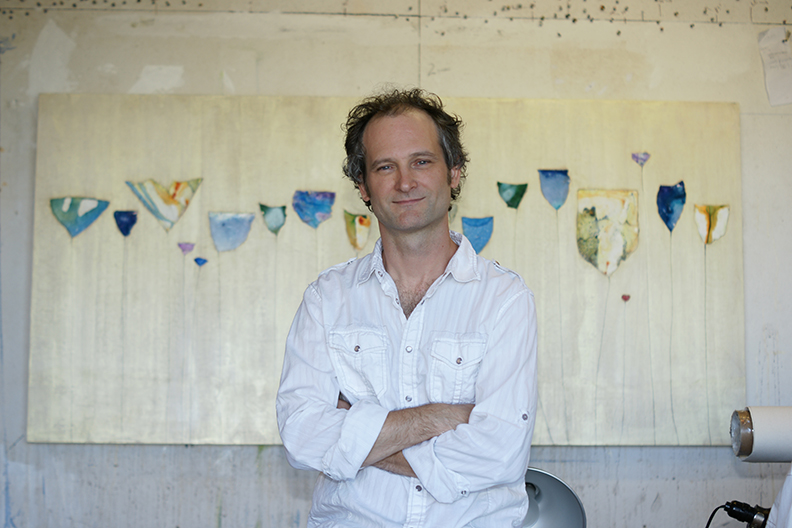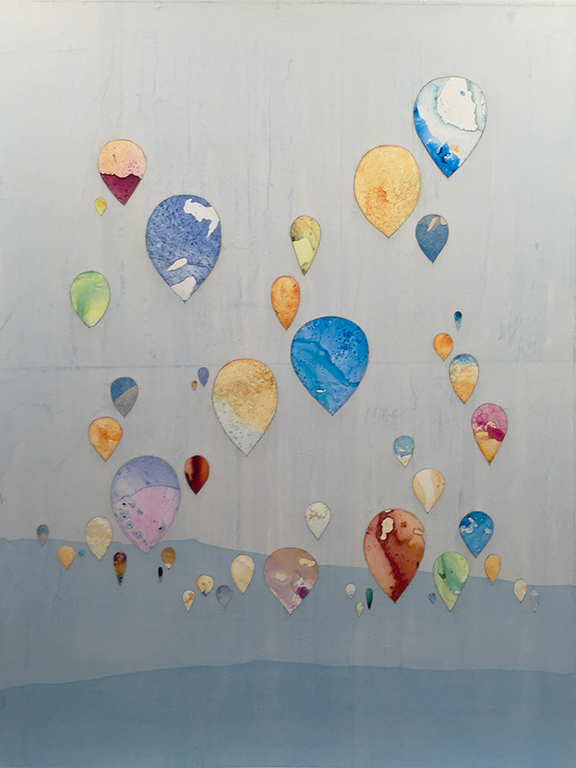Soaring with Peter Kuttner

Writer Amanda Christmann
Photography Submitted by Grace Renee Gallery
[dropcap]S[/dropcap]ome artists approach a canvas with dreams in their heads, dipping brushes into paint and watching with fascination as work spontaneously emerges. Other artists yield to a process, layer by layer, their ideas materializing in a labor of love.
The work of artist Peter Kuttner straddles a wavering line between improvisation and process. Though his whimsical landscapes seem to appear impromptu, Kuttner has perfected a step-by-step method of creating the vivid swirls of color that seem to pop from his canvas.
As a young artist, Kuttner admired an unlikely pair of artists: Walt Disney and Claude Monet. Looking at Kuttner’s art, it all makes sense.
The bulk of his work involves playful scenes of brightly colored hot air balloons, boats or flowers. He has a knack for capturing a nearly animated spirit of happiness in all he does, which, like Disney, is part of his allure.
Whirls of color fill Kuttner’s still life creations, an ode to Monet’s Garden at Giverny and other classics. Though Kuttner is not an impressionist artist, he seems to channel the purity of Monet’s aesthetic.
A Unique Medium
At the heart of Kuttner’s work is a conscientious effort to create zero-waste art.
“It started from a conservation standpoint. I didn’t like throwing things way—I still don’t,” he said. “I would scrape my palettes for the next day and I’d end up with these vibrant paint chips. I saw that there was value in them.”
In a nod to both creativity and sustainability, Kuttner combines trickles and drops of acrylic paints to make brightly colored chips. He skillfully trims and combines them to form balloons and other elements.
Pieces from his Cut-Out series have been compared to the work of Matisse in their utilitarian simplicity. Kuttner utilizes negative space and abstracted details to create lively and mesmerizing texture and depth.
Though his name is now dropped into conversations about notable contemporary artists, Kuttner remains modest about his art.
“I don’t do many elevator pitches,” he says from his Tucson studio. He laughs from beneath the brim of a brown cap. His stubble is a couple of days old, and he looks relaxed in a brown t-shirt. Like his work, he is disarmingly candid.
“The first thing I want to do when I create a piece is make it colorful and happy. I like to go to this happy feeling with my work.
“I’m also process-oriented. There are a lot of steps I follow to get there. To make paint scrapes, I paint on glass or on a mirror, and then I let that dry. Once it’s dry, I cover it with gesso and let it dry again so I can pull the paint off the glass.
“The whole process provides brilliant, pure, unadulterated color that you just can’t get from mixing colors on a canvas. Every time, there are unforeseen things that happen. I love the spontaneity of color production.”
Kuttner’s methods and skill have evolved over time.
“My first attempts were really bad paintings, but I got better at it. I feel like I’m still getting better at it every time, and I’ve been doing the Cut-out series for 10 years.”
Setting His Own Course
Kuttner’s work has been embraced by Architectural Digest magazine; in popular films and television shows, including Californication, Two and a Half Men, and Nashville; and has been exhibited alongside other prominent American contemporary artists in shows, museums, and private, royal and corporate collections from coast to coast.
Not bad for a guy who entered college thinking he could never make it as an artist.
Kuttner grew up just south of Boston. His mother was also an artist, though she never received formal training, and his father was a musician.
“My mother did illustrations, and I really loved watching her draw. I discovered early on that I loved art, too,” he said.
“In first grade, my teacher had the whole class create crayon drawings, then put watercolors on top of that. It was a resistance-type painting. The best part was that we got to show our drawings at the local library.
“It was my first art show. I still remember how I loved having people see my work, and I also remember that I saw a difference in my work from the other kids’ work.”
For as long as he can remember, Kuttner had wanted to be a Disney animator. He spent hour upon hour drawing sketches, and he was quite good. When it came time to choose a college degree, however, he tried to be more practical.
“When I went to college, I didn’t know I was going to be an artist,” he said. “I majored in art history because I thought I’d have an easier time getting a job afterward. Fortunately, I had teachers tell me, ‘You’ve got a talent. Why don’t you pursue a degree at an art college?’ I did, and thankfully I found a great art school.
Kuttner transferred to Ringling School of Art & Design in Florida, which was, at the time, a farm school for Disney animators. However, times were changing. At about the same time he graduated, animation turned away from hand-drawn sketches to digital imagery.
He did realize his dream of working at Disney World, but not as an animator. Instead, he dressed up as a cloddish cowboy named Judge Benedict and served food in one of the restaurants.
“I worked for Disney for eight years,” he said. “I learned a lot of good things and bad things—but I kept all the good things. I never worked in their animation studio at all, but I got to visit quite a bit. Disney definitely gave me a lot.”
In his spare time, Kuttner painted. He worked in oils en plein air creating landscapes.
“I loved color,” he said. “It made sense to start painting.”
His face broke into a shy smile.
“I didn’t know it would get me this far.”
Eventually, he moved to Phoenix and began working in an art cooperative. He developed new techniques in his own paintings, but he also earned commissions recreating work for the cooperative.
“I learned a lot about business and art,” he said. “I didn’t enjoy recreating other people’s work. When I left, I made sure that everything I created was brand new and that it was nothing anyone had ever seen. I worked hard.”
He began selling his work through local galleries in 2004. His style and medium have evolved along the way, and he’s continued to find ways to connect to people through art.
His latest works featuring hot air balloons were inspired by a trip to New Mexico where he watched the Albuquerque International Balloon Fiesta. Many of his newer pieces will be on display at Grace Renee Gallery during an artist reception Nov. 21.
“I’m very proud that I do art for a living,” he said. “I feel like I’m fortunate that I kind of stumbled into something I really loved.”
Every bit of happiness Kuttner puts into his paintings seems to come back to him.
“I’ve gotten so much value and so much—I don’t know—I hate to use the term ‘healing’—but working with color does something to you. I feel lucky every day that I do what I do.”
Peter Kuttner Artist Reception
Nov. 21 | 4–7 p.m. | Grace Renee Gallery | Historic Spanish Village | 7212 E. Ho Hum Rd. #7, Carefree | 480-575-8080 | gracereneegallery.com


